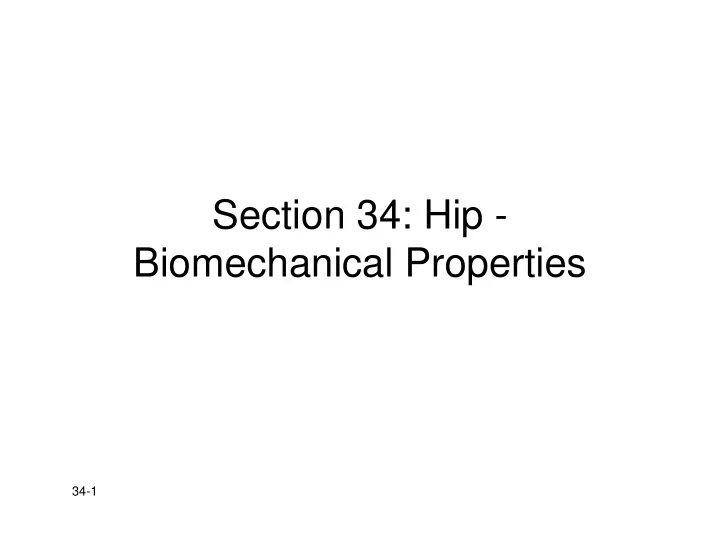

Section 34: Hip - Biomechanical Properties 34-1
Biomechanics Biomechanics • Dynamic analysis much more complex Dynamic analysis much more complex • Forces across hip joint combination of: – Body weight Body weight – Ground reaction forces – Abductor muscle forces 34-2 From: Stone
From: Bajekal 34-3
HIP ANGLES OF DAILY ACTIVITY ACTIVITY From: Gough 34-4
2D Static Analysis 2D Static Analysis • One legged stance One legged stance 5/6 BW on femoral head • Ratio of lever arms to BW 3:1 34-5 From: Stone
Biomechanics of Cane Biomechanics of Cane • Cane in Contralateral Cane in Contralateral hand decreases JRF • Long moment arm g makes so effective • 15% BW to cane reduces joint contact forces by 50% 34-6 From: Stone
INFLUENCE OF MUSCLE ACTIVITY ACTIVITY • Muscles will often Muscles will often contract, not to cause movement, but to equalise stress accumulations on l ti bones. • A good example of • A good example of this is the hip joint and the femur. and the femur. 34-7 From: Gough
BIOMECHANICS OF MUSCLE INFLUENCE IN THE HIP INFLUENCE IN THE HIP • BONE IS BONE IS STRONGER IN COMPRESSION • HOWEVER WHERE THERE IS COMPRESSION THERE IS ALSO A TENSILE STRESS TENSILE STRESS 34-8 From: Gough
BIOMECHANICAL ANALYSIS OF MUSCLE FORCE MUSCLE FORCE • Each lower limb Each lower limb makes up around 15% of total body weight. • Therefore • A man weighing 800 N • W LL = 15%/100%=800x0.15 = 120 N 120 N 34-9 From: Gough
Common Injuries Common Injuries • Dislocation -femoral head moves out of the acetabulum acetabulum -usually it goes posterior into notch -position typically flexion, adduction, and p yp y , , internal rotation -common mechanism: knee to dashboard during traffic collision during traffic collision -signs and symptoms: extreme pain, obvious deformity, unwilling to move the extremity the extremity 34-10 From: Howard and Rivera
COMMON INJURIES COMMON INJURIES • Hip Fracture Hip Fracture -most frequently occurs through the femoral neck neck -a direct blow to the lateral hip -signs and symptoms: pain, swelling, and signs and symptoms: pain swelling and loss of function -the involved leg will appear shortened and -the involved leg will appear shortened and will be externally rotated 34-11 From: Howard and Rivera
Recommend
More recommend